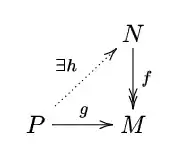Glossary of module theory
Module theory is the branch of mathematics in which modules are studied. This is a glossary of some terms of the subject.
See also: Glossary of ring theory, Glossary of representation theory.
A
- algebraically compact
- algebraically compact module (also called pure injective module) is a module in which all systems of equations can be decided by finitary means. Alternatively, those modules which leave pure-exact sequence exact after applying Hom.
- annihilator
- 1. The annihilator of a left -module is the set . It is a (left) ideal of .
- 2. The annihilator of an element is the set .
- Artinian
- An Artinian module is a module in which every decreasing chain of submodules becomes stationary after finitely many steps.
- associated prime
- 1. An associated prime.
- Azumaya
- Azumaya's theorem says that two decompositions into modules with local endomorphism rings are equivalent.
B
- balanced
- balanced module
- basis
- A basis of a module is a set of elements in such that every element in the module can be expressed as a finite sum of elements in the basis in a unique way.
- Beauville–Laszlo
- Beauville–Laszlo theorem
- bimdule
- bimodule
C
- character
- character module
- coherent
- A coherent module is a finitely generated module whose finitely generated submodules are finitely presented.
- completely reducible
- Synonymous to "semisimple module".
- composition
- Jordan Hölder composition series
- continuous
- continuous module
- cyclic
- A module is called a cyclic module if it is generated by one element.
D
- D
- A D-module is a module over a ring of differential operators.
- dense
- dense submodule
- direct sum
- A direct sum of modules is a module that is the direct sum of the underlying abelian group together with component-wise scalar multiplication.
- dual module
- The dual module of a module M over a commutative ring R is the module .
- Drinfeld
- A Drinfeld module is a module over a ring of functions on algebraic curve with coefficients from a finite field.
E
- Eilenberg–Mazur
- Eilenberg–Mazur swindle
- elementary
- elementary divisor
- endomorphism
- The endomorphism ring.
- essential
- Given a module M, an essential submodule N of M is a submodule that every nonzero submodule of M intersects non-trivially.
- Ext functor
- Ext functor.
- extension
- Extension of scalars uses a ring homomorphism from R to S to convert R-modules to S-modules.
F
- faithful
- A faithful module is one where the action of each nonzero on is nontrivial (i.e. for some in ). Equivalently, is the zero ideal.
- finite
- The term "finite module" is another name for a finitely generated module.
- finite length
- A module of finite length is a module that admits a (finite) composition series.
- finite presentation
- 1. A finite free presentation of a module M is an exact sequence where are finitely generated free modules.
- 2. A finitely presented module is a module that admits a finite free presentation.
- finitely generated
- A module is finitely generated if there exist finitely many elements in such that every element of is a finite linear combination of those elements with coefficients from the scalar ring .
- fitting
- fitting ideal
- five
- Five lemma.
- flat
- A -module is called a flat module if the tensor product functor is exact.In particular, every projective module is flat.
- free
- A free module is a module that has a basis, or equivalently, one that is isomorphic to a direct sum of copies of the scalar ring .
G
- Galois
- A Galois module is a module over the group ring of a Galois group.
H
- graded
- A module over a graded ring is a graded module if can be expressed as a direct sum and .
- homomorphism
- For two left -modules , a group homomorphism is called homomorphism of -modules if .
- Hom
- Hom functor.
I
- indecomposable
- An indecomposable module is a non-zero module that cannot be written as a direct sum of two non-zero submodules. Every simple module is indecomposable (but not conversely).
- injective
- 1. A -module is called an injective module if given a -module homomorphism , and an injective -module homomorphism , there exists a
-module homomorphism such that .
 The module Q is injective if the diagram commutes
The module Q is injective if the diagram commutes- The following conditions are equivalent:
- The contravariant functor is exact.
- is a injective module.
- Every short exact sequence is split.
- 2. An injective envelope is a maximal essential extension, or a minimal embedding in an injective module.
- 3. An injective cogenerator is an injective module such that every module has a nonzero homomorphism into it.
- invariant
- invariants
- invertible
- An invertible module over a commutative ring is a rank-one finite projective module.
- irreducible module
- Another name for a simple module.
J
- Jacobson
- density theorem
K
- Kaplansky
- Kaplansky's theorem on a projective module says that a projective module over a local ring is free.
- Krull–Schmidt
- The Krull–Schmidt theorem says that (1) a finite-length module admits an indecomposable decomposition and (2) any two indecomposable decompositions of it are equivalent.
L
- length
- The length of a module is the common length of any composition series of the module; the length is infinite if there is no composition series. Over a field, the length is more commonly known as the dimension.
- localization
- Localization of a module converts R modules to S modules, where S is a localization of R.
M
- Mitchell's embedding theorem
- Mitchell's embedding theorem
- Mittag-Leffler
- Mittag-Leffler condition (ML)
- module
- 1. A left module over the ring is an abelian group with an operation (called scalar multipliction) satisfies the following condition:
- ,
- 2. A right module over the ring is an abelian group with an operation satisfies the following condition:
- ,
- 3. All the modules together with all the module homomorphisms between them form the category of modules.
- Noetherian
- A Noetherian module is a module such that every submodule is finitely generated. Equivalently, every increasing chain of submodules becomes stationary after finitely many steps.
- normal
- normal forms for matrices
- principal
- A principal indecomposable module is a cyclic indecomposable projective module.
- primary
- A primary submodule
- projective
- A -module is called a projective module if given a -module homomorphism , and a surjective -module homomorphism , there exists a -module homomorphism such that .
 The characteristic property of projective modules is called lifting.
The characteristic property of projective modules is called lifting.- The following conditions are equivalent:
- The covariant functor is exact.
- is a projective module.
- Every short exact sequence is split.
- is a direct summand of free modules.
- In particular, every free module is projective.
- 2. The projective dimension of a module is the minimal length of (if any) a finite projective resolution of the module; the dimension is infinite if there is no finite projective resolution.
- 3. A projective cover is a minimal surjection from a projective module.
- quotient
- Given a left -module and a submodule , the quotient group can be made to be a left -module by for . It is called a quotient module or factor module.
- radical
- The radical of a module is the intersection of the maximal submodules. For Artinian modules, the smallest submodule with semisimple quotient.
- rational
- rational canonical form
- reflexive
- A reflexive module is a module that is isomorphic via the natural map to its second dual.
- resolution
- resolution
- restriction
- Restriction of scalars uses a ring homomorphism from R to S to convert S-modules to R-modules.
- Schanuel
- Schanuel's lemma
- snake
- Snake lemma
- socle
- The socle is the largest semisimple submodule.
- semisimple
- A semisimple module is a direct sum of simple modules.
- simple
- A simple module is a nonzero module whose only submodules are zero and itself.
- stably free
- A stably free module
- structure theorem
- The structure theorem for finitely generated modules over a principal ideal domain says that a finitely generated modules over PIDs are finite direct sums of primary cyclic modules.
- submodule
- Given a -module , an additive subgroup of is a submodule if .
- support
- The support of a module over a commutative ring is the set of prime ideals at which the localizations of the module are nonzero.
- tensor
- Tensor product of modules
- Tor
- Tor functor.
- torsionless
- A torsionless module.
- uniform
- A uniform module is a module in which every two non-zero submodules have a non-zero intersection.
- John A. Beachy (1999). Introductory Lectures on Rings and Modules (1st ed.). Addison-Wesley. ISBN 0-521-64407-0.
- Golan, Jonathan S.; Head, Tom (1991), Modules and the structure of rings, Monographs and Textbooks in Pure and Applied Mathematics, 147, Marcel Dekker, ISBN 978-0-8247-8555-0, MR 1201818
- Lam, Tsit-Yuen (1999), Lectures on modules and rings, Graduate Texts in Mathematics No. 189, Berlin, New York: Springer-Verlag, ISBN 978-0-387-98428-5, MR 1653294
- Serge Lang (1993). Algebra (3rd ed.). Addison-Wesley. ISBN 0-201-55540-9.
- Passman, Donald S. (1991), A course in ring theory, The Wadsworth & Brooks/Cole Mathematics Series, Pacific Grove, CA: Wadsworth & Brooks/Cole Advanced Books & Software, ISBN 978-0-534-13776-2, MR 1096302
N
P
Q
R
S
T
U
References
This article is issued from Wikipedia. The text is licensed under Creative Commons - Attribution - Sharealike. Additional terms may apply for the media files.